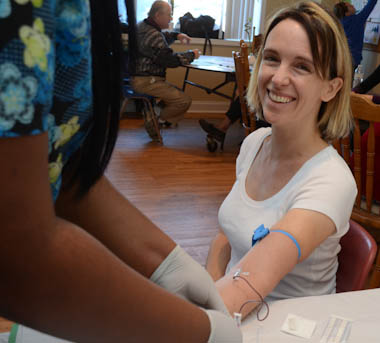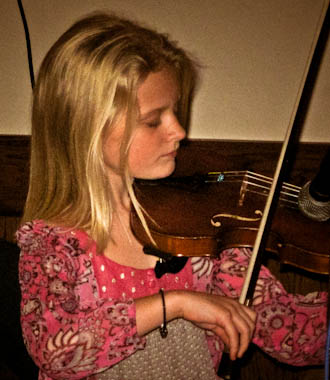
See, it doesn’t hurt. Dubliner Siobhan Lyons, executive director of the Irish Immigration Center, gets tested for Tay Sachs.
Martin Fay comes from an Irish family blessed by longevity so he wasn’t worried that contributing a few vials of blood to a study of Tay-Sachs disease in the Irish was going to bring him bad news.
“My genes are all right,” said the Drexel Hill man, his youngest daughter, Orla, standing by his side at the Irish Immigration Center in Upper Darby a few Saturdays ago. “But if I can keep somebody else from going down that road, I thought, go for it.”
Most of the people who came to the center to have their blood tested weren’t worried about passing on a gene that could affect their children. Some were seniors who learned about the study at special programs at the immigration center or the Irish Center. They’d had their children—and their grandchildren. Tay Sachs is largely a disease of babies. Born seemingly normal, children with Tay-Sachs start to deteriorate at about six months, slowly losing their sight, their ability to move, their intellect. Most of them die by the time they’re 5.
Tay-Sachs is caused by a variety of genetic mutations of chromosome 15, some more common in certain ethnic groups, that affect the production of a vital enzyme called hexosaminidase (Hex-A) that clears out fatty protein and other substances from the tissues and nerve cells of the brain. That regular housecleaning allows an infant to develop vision, hearing, movement, and other vital functions. Without it, a baby will start to deteriorate physically and mentally. There is no cure and no effective treatments.
The aim of the research, started by Adele Schneider, MD, a pediatric geneticist at Albert Einstein Medical Center, is to determine the carrier rate among the Irish, who appear to be at higher risk of the disease than the general population. Traditionally, Tay-Sachs has been considered a genetic disease among Jewish people, mainly Ashkenazi Jews who trace their roots to southwestern Asia, but who settled in Eastern Europe. Their carrier rate is about 1 in 27. French Canadians and Louisiana Cajuns have the same carrier rate. Current research—which is scant—suggests that the genetic mutation appears in about 1 in 50 people of Irish descent.
“There’s really nothing in the medical literature that gives an accurate carrier rate in the Irish,” said Dr. Schneider. Her impetus for launching the study, which is funded by the National Tay Sachs and Allied Diseases of the Delaware Valley and the Einstein Foundation, was not just the lack of good data, but the three Irish-American children she’s seen in the last 10 years who had the disease. Read about two of those children here.
What made that remarkable is the rarity of Tay-Sachs. There are only about 16 cases diagnosed every year in the US.
“What we want to do is test as many people with as pure Irish blood as we can get to see if the numbers are significant enough that we can recommend that Irish parents be screened the for the disease as we do for Jewish parents,” she explained. “We don’t want to have any more families go through the heartbreak of finding out when they have a baby that that baby is going to die.”
The study, which is funded for two years, will also test adults with at least three Irish grandparents in other Irish-centric cities such as New York and Boston. Along with genetic testing, participants also receive genetic counseling where they will learn that just because they’ve never seen Tay-Sachs in their line doesn’t mean they don’t carry the genetic mutation. It may just mean they’ve unwittingly chosen the right mate.
Tay Sachs is what is known as an autosomal recessive disorder. What that means is that “Tay Sachs occurs only when two carriers have children,” explained Divya Shah, a genetic counselor from Einstein. With every pregnancy, a couple runs a 25 percent chance of having a child with the disease, a 50 percent chance of having a child who is a carrier but who never develops any symptoms, and 25 percent odds of having a child who is not a carrier.
But those are just odds. In real life, it’s possible that carrier parents of four could have four normal children or four affected children or two carriers and one affected child and one normal child—it’s the luck of the draw.
More free screenings for Irish and Irish Americans are being planned, said Amy Beth Weaver, Einstein’s genetic counseling coordinator. You can find out more about the study here, or, if you’re interested in participating in the research, contact Weaver at irish@tay-sachs.org or call 215-887-0877. Testing is free for qualified adults and all results are confidential.
See photos from the day.




